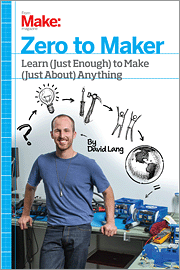30 Jun 2014
OpenROV is an underwater robot controlled through a web browser. The server-side of the web app is written in Node.js, running on a BeagleBone Black inside the OpenROV.
You don’t need to know Node.js in order to pilot an OpenROV. And you don’t need to do anything in this article to construct an OpenROV from a kit. But if you’re the kind of maker who likes to dig deep into a project, you might enjoy exploring Node.js.
Continue reading →
28 Jun 2014
You know what the trouble is? We used to make things in this country, build things. Now we just put our hand in the next guy’s pocket.
~Frank Sobatka
David Lang is a maker. After a stint with a struggling Silicon Valley startup, David teamed up with former NASA engineer Eric Stackpole to build an underwater robot called OpenROV. That’s a two-sentence oversimplification of David’s maker journey, detailed in his book: Zero to Maker: Learn (Just Enough) to Make (Just About) Anything.
The book starts off like a novel, with the exploration of the mysterious Hall City Cave and an 1840s-era gold robbery. Fast-forward to the present day where a multi-disciplinary team of makers joins forces to create an inexpensive vehicle for underwater exploration.
The author was not a born maker. But through force of will, discipline, and the right mentorship, he grew from non-maker to co-founder of the OpenROV company in roughly one year.
Continue reading →
27 Jun 2014
How many motors are in the typical automobile? The knee-jerk response might be “one, the big metal thing under the hood”. Upon further reflection, we may recall the motors that operate many devices in today’s automobile: windshield wipers, power windows, door locks, sun roof, reclining seats, and so on. Power devices were once luxury equipment. Today, since motors have fallen in price, most cars include these luxury items as standard equipment.
We take motors for granted, therefore motors have disappeared. And now, as it becomes possible to add a computer and an IP address to almost anything electronic, we bring about the Internet of Things (IoT). Computers are disappearing too.
Continue reading →
16 Jun 2014
In the early days of robots people said, ‘Oh, let’s build a robot’ and what’s the first thought? You make a robot look like a human and do human things. That’s so 1950s. We are so past that.
~Neil deGrasse Tyson

OpenROV is an underwater robot, roughly the size of a toaster, and definitely not human-shaped. The device is controlled through a Node.js-based web app. Former NASA researcher Eric Stackpole and Make Magazine columnist David Lang are on a mission to democratize ocean exploration in the same way that Jobs and Woz sparked the democratization of computing. Eric and David pooled their talents to launch OpenROV, building on the foundation laid by Moore’s Law and the open source software movement.
Continue reading →
31 May 2014
The RayHightower.com blog is built on Octopress and hosted on GitHub Pages. Recently, after I deployed a site update, GitHub emailed me a Page build warning message. Since this was just a warning, I ignored it while I attacked more pressing tasks (not always a good idea).
Today I finally took the time to research the topic so I could figure out what to do next. This article is the result of that research.
Continue reading →






